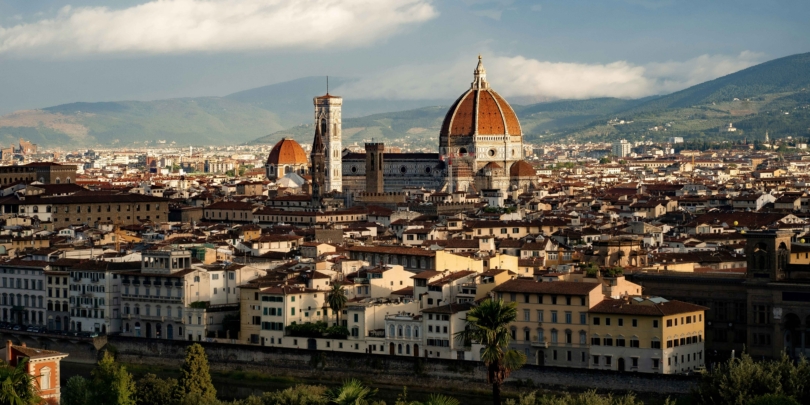
Pizza, lasagna and beyond – Italian specialties to tempt your teenagers
Sawday's Expert
5 min read
Italy’s approach to food is legendary, but most people outside the country only ever get a glimpse of the variety on offer, even when it comes to world-renowned classics. Traditional Italian dishes reflect the farming culture, rooting them firmly in regional climates and geography, so the products and the palates are as diverse as the land itself. If you’re taking your teens to Italy, then you can sell it to them, culinarily speaking, on pizza and lasagna, knowing full well that there’s an enormous amount to be discovered behind and beyond those familiar names.
Pizza
The pizza which we all think we know, covered in fresh bufala mozzarella cheese, is actually a Naples specialty. In Lombardy, pizza is mostly made with pungent gorgonzola, while in Puglia they use burrata cheese. Shapes vary greatly as well, from the classic rounds to pizza al metro (by the metre) an oblong shape divided into sections with different ingredients along the way and not, just to make this clear, an invitation for your kids to order a few metres of dinner. Less well known in the UK is pizza al taglio, the Italians’ favoured take away variety, in which rectangular sheets are displayed with a variety of toppings then cut with scissors, weighed, wrapped and taken out. A personal favourite, in my opinion the king of pizza al taglio, is Gabriele Bonci, whose Bonci Pizzarium in Rome has endless trays of pizza in every flavour imaginable! Worth seeking out if you’re in the capital, or even making a special trip!


Campania’s Margherita
Yes, we all know the margherita, but there’s something special about eating one in the place from which it’s swept the world. The Neapolitan pizza was invented, in a basic form, around 1600, arising from the need to make traditional crushed more flavoursome. Initially the dough was cooked in wood-burning ovens, seasoned with garlic, lard, coarse salt and sometimes the local caciocavallo cheese topped with basil. It was well over 200 years later that the first classic tomato and mozzarella pizza as we know it emerged. In 1889, the sovereigns of Italy, King Umberto I and Queen Margherita, visited Naples and the name Pizza Margherita was adopted in her honour.
Lazio’s Pinsa Romana
The Pinsa Romana was born in Lazio, near Rome, several centuries ago, but has waited until very recently to become a staple of Italian cuisine. It arose from the need to utilise every gram of flour produced, even those that were normally considered “waste”, leading to a light dough that was baked to a crunch. The end result is similar to foccacia, originally flavoured only with oil, salt and sage but now with a greater variety of flavours.
Liguria’s Focaccia Genovese
Focaccia is also the specialty of Liguria, where this type of pizza, Focaccia Genovese, is consumed in its most natural form. A simple dribble with local olive oil, sea salt and perhaps a sprig of rosemary, topped only with onion or sage leaves, it’s often accompaniment in the morning to a cappuccino or in the evening to a glass of Sciacchetrà white wine.
Sicily’s Sortino
Way down south they do things a little differently, so the Sicilian version, Il Pizzolo Siciliano, is a sort of sandwich; a stuffed pizza with salami, mortadella prosciutto cold cuts, provolone cheese, lettuce, cooked vegetables (spinach, zucchini, aubergine, peppers) , minced meat such as ragù, and parmesan. It’s not the easy finger food that open pizzas are, but well worth taking on with knife and fork.
Lasagna
A staple of students, pub menus and rainy day Sundays, lasagna is another classic Italian food we see only one layer of. Probably the most familiar version for Brits is from Bologna, incidentally a city which is very keen to distance itself from the pasta sauce we’ve named after it. Here we see the bechamel sauce layered with ragu and grated parmesan, although the frequent use of green sheets of spinach pasta might surprise your kids.


Naples’ egg variation
The Neapolitan version of lasagna tends to be heavier than most, with thick wheat pasta, more meat and chopped hard-boiled eggs as a topping.
Veneto’s Pasticcio
This version of lasagna has a meat sauce mixing both pork and beef, and is also packed with secret extras like sauteed onions, carrots, celery and red wine. There’s a little nutmeg in the bechamel and the slight sweetness is either because of, or has lead to, it’s popularity for Christmas dinner. Another popular variation in the region is the no-meat recipe, with strong gorgonzola cheese and radicchio Trevignano lettuce.
Marche’s Vincigrassi
In the Marches, a heart-stopping variation of lasagna has emerged. Known as “vincigrassi” or “fat-winning” due to the presence of lard, pepper and semolina instead of pasta, it’s a rich, delicious dish that will have you fuelled up ready for anything, after a short nap.
Other Italian specialities to look out for
Liguria is the home of another classic dish the British have taken to heart – pasta with classic green pesto of basil, garlic and pine nuts. Sampling it here, with the ingredients freshly picked and prepared, is a completely different experience to picking up a jar in the supermarket. In Emiliana Romagna, try tortellini stuffed with meat and served in a broth and in Puglia, tiny orecchiette with turnip greens, known as cime di rapa. Southern Lombard is the place to try risotto, as the crop is grown everywhere and the variation of flavours is endless, while in Piemonte, you should make a point of sampling one of the many grilled meat dishes flavoured with the region’s prized white truffles.
View all of our places to stay in Italy >
Planning your next adventure? Find more inspiration on our midlife travel page.
Inspire me >Share this article:
You might also like
7 days in Puglia by train: Seaside towns and the Florence of the south

Christopher Wilson-Elmes
Sawday's Expert
5 min read
Surf and supper: Six great Puglian beaches and where to eat

Christopher Wilson-Elmes
Sawday's Expert
5 min read
48 hours in Florence

Annabelle Thorpe
5 min read












